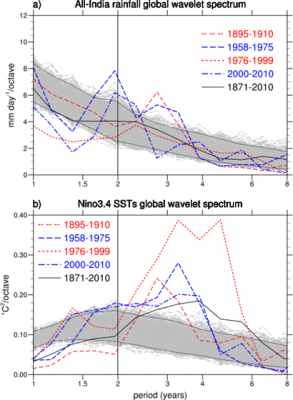Decadal Variability Influences Year-to-year Climate Fluctuations in the Tropical Indo-Pacific Region
Coupled air-sea processes in the Indo-Pacific region associated with the tropospheric biennial oscillation (TBO) should make the Indian monsoon and El Nino/Southern Oscillation (ENSO) perfectly biennial, thus providing considerable skill for climate predictions a few years in advance. However, sometimes the Indo-Pacific climate system is more biennial than others, raising the question as to what is causing the strength of the TBO to wax and wane. We show that multi-decadal variability associated with the Interdecadal Pacific Oscillation (IPO) affects the nature of year-to-year variability of the TBO. Thus when tropical Pacific sea surface temperatures (SSTs) are somewhat warmer than normal, as they were from the late-1970s to the late-1990s, the Indo-Pacific climate system is less biennial and the TBO is weak. Conversely, when the IPO is in a negative phase with somewhat cooler than normal SSTs, as it was just prior to the 1970s and after the late-1990s, the TBO is stronger and the monsoon-ENSO system is more biennial. This implies that if the phase of the IPO could be predicted in a decadal climate prediction system, there would be added short-term year-to-year prediction skill for the monsoon-ENSO system in the Indo-Pacific region.

